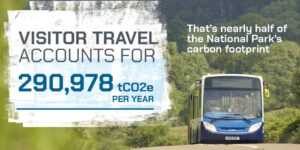
Spotlight on Sustainable Transport
There are just 48 hours left to join our conversation on the future of the National Park – that’s plenty of time to tell us how you think we can provide low-carbon travel opportunities for everyone!
Head of Visitor Services Kenny Auld has written about the challenges of sustainable transport in rural areas and how we can address these issues.
The Carbon Footprint Assessment for the National Park completed in 2022 shows that visitor travel is our single biggest source of greenhouse gas emissions, making up nearly half of our overall footprint.
Currently, car-based travel dominates how people travel to the National Park. In 2019/20, 79% of visitors told us they arrived in the National Park by car and 73% used a car to explore the area. The majority of people who have shared their views so far in this consultation have also told us that the car is their most frequent mode of transport. This is especially concerning considering that Transport Scotland predicts car-based travel will continue to increase by up to 40% by 2037 if there is no intervention.

We know that if we are to become a Net Zero National Park by 2040, we need to make a transformational change in the way that people get to, from and around the National Park. Specifically, we need to see a significant reduction in car journeys.
However, even as we encourage people to leave their cars behind and use more sustainable and active modes of transport, we are acutely aware that large parts of the National Park still can’t be reached without a car. This is further exacerbated by gaps in local public transport services, which were understandably designed for essential services for residents.
As a result, we are seeing a high and ever-increasing volume of cars coming to and travelling around the National Park, which in turn can bring congestion on rural roads and puts pressure on our local communities.
So what can we do to address this issue?
The National Park Authority has been working in recent years to develop short term measures to reduce car journeys to and within the National Park. This has included working with partners to pilot a journey planner app that helps visitors find out the carbon impact of their journey and consider more climate-friendly options. A comprehensive study to increase understanding of the barriers and opportunities for sustainable travel in the Park has also recently been completed and we are considering how we respond to its findings.
Over 2022 and 2023, a pilot project has also been ongoing to explore a shuttle bus service in the National Park in the peak visitor season. Despite two rounds of procurement for separate bus routes, we have unfortunately been unable to secure a bus operator to facilitate this service – demonstrating significant ongoing challenges facing the rural transport sector.
These projects have shown that in the longer term, we need to see a whole system change to create a system of well-connected, dependable and affordable public and active travel services for both residents and visitors to provide viable, attractive and reliable alternatives to the private car.
This increase in viable car-free travel options will not only help to reduce emissions and relieve pressure on congested local roads, it will also make the National Park a more inclusive visitor destination for those who do not have access to a car – helping everyone to be able to connect with nature here.
The National Park Authority is highly dependent on action by partners like local authorities, regional transport partnerships or transport providers in grasping this opportunity. But there are also lots of actions that everyone can take to collectively reduce our transport emissions. For example, if you’re a business owner, could you work with us to help incentivise using public or active travel options for your customers? If you live in the National Park, how can we help you to live well more locally without relying on a car? And if you visit the National Park, what other forms of transport could you use to explore other areas and have a more sustainable adventure?
We want to hear your ideas and what role you can play to help provide and encourage low-carbon travel for everyone. Visit our Commonplace consultation website share your thoughts. But hurry, the deadline to share your comments is 5pm this coming Wednesday (19th July 2023).

